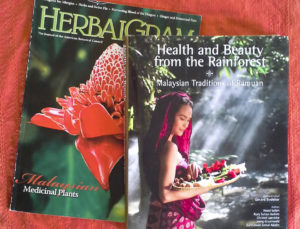Health and Beauty from the Rainforest : Malaysian Traditions of Ramuan. / Gerard Bodeker, editor-in-chief. Editions Didier Millet, 2009. 256 pages. Illustrations in color.

Health and Beauty from the Rainforest is a collection of essays that describe traditional uses of herbs for wellness in all stages of life. Malaysian Ramuan, a culturally meaningful term, here refers to the art and science of combining herbs and plants for therapeutic use at home and at Malaysian health spas. It is believed that specific combinations of herbs with foods can either harm or heal the body.
Throughout Health and Beauty from the Rainforest, a reader encounters the rich texture of Malaysian history, which celebrates and shares the multi-ethnic composition of its peoples. A year after the book’s publication, an article by Steven Foster appeared in the American magazine, HerbalGram, entitled in part, “Balancing Nature and Wellness—Malaysian Traditions of “Ramuan”. It described five of the healing plants included in Ramuan: Torch Lily, Ylang Ylang, Plumeria, Citrus aurantifolia or Kaffir Lime, and Hibiscus.
I mention this article because its focus is on plants that are well known outside of Southeast Asian rainforests. Of course in Malaysia, medicinal plants number over 2,000 (S.Foster’s article says over 20,000! species), with an overwhelming number being unfamiliar to those who live north of the tropics.
Malaysia encourages cultural exchange; some of the more successful of these interactions resulted in now time-honored traditions centered around food and botanical medicine. As generations of ethnic Chinese, Indians, Middle Easterners, and Europeans who travelled to the country stayed on and became Malaysians, herbal and medicinal conventions from each group have been accepted by the population as a whole.
Health and Beauty from the Rainforest offers a glimpse into a world where men and women use ramuan throughout their lives. While some purchase prepared formulations, the possibility of experiencing native plants does exist and is prized by those who seek them. For the Malaysian, it depends, much like everyone else, on how much time and money they have to devote to self-care.
Ramuan engages the system of plant energetics. This system categorizes healing plants according to their capacity to heat up, cool down, astringe, or moisten the body’s tissues. So, these energetic properties can change or mitigate the body’s qualities which also can be hot, cold, dry, moist, and additionally, windy or gassy.
It turns out that many traditional health systems share this perspective of plant energetics. And in Malaysia with its many cultural influences, the correspondence of botanical medicines with human physical conditions became the firm foundation of ramuan. It figures extensively in the lives of women: for care during puberty, prior to marriage, during pregnancy, in post-partum, and in aging. For men, ramuan, in special formulations to support vigor and strength, is a dependable source of vitality. For both sexes as they age, massage, exercises, as well as ramuan are appropriate. These beautifying and strength-building processes translate easily to the health spa with offerings in both Chinese medicinal spas as well as Ayurvedic spas.
I’ve noted a suggestion from nutritionists is that eating greens with a bit of fat helps digest them and helps absorb the vitamins and minerals they have. Malay herbal salad, known as ulam, are greens prepared for their therapeutic value. Ulam can be composed of aromatic herbs such as mint, tulsi, lemongrass and Kaffir-lime leaves. These are dipped into a sambal, “a paste of fermented shrimp and chili sauce” plus fried grated coconut. Many other herb combinations are possible, as long as the balance of energetics is maintained.
You can watch a video on Malay herbal salad, or Ulam, by Malaysian-American Christine Leong here.
Follow


